Da Massimo Pizza, Sapporo
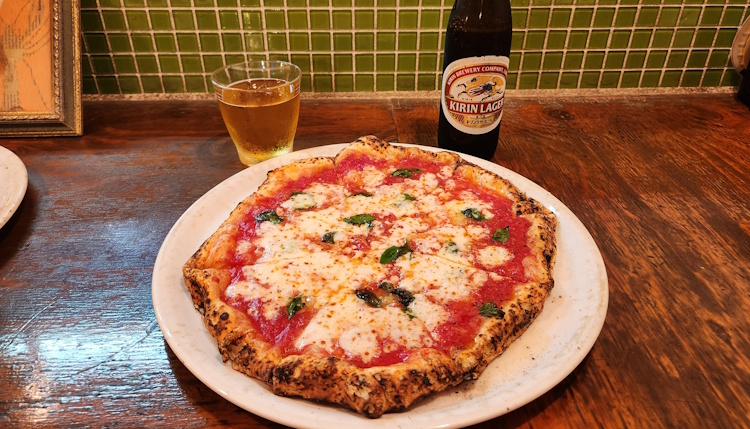
As part of ongoing coverage of the best pizza in Sapporo, it is time we pay homage to Da Massimo Pizza, in Shiroishi, Sapporo.
If not the best, Da Massimo is certainly one of the best pizzas in Sapporo, or in Hokkaido for that matter. I’m not particularly excited about Neapolitan-style pizzas, and I still give this one an enthusiastic “two thumbs up.”
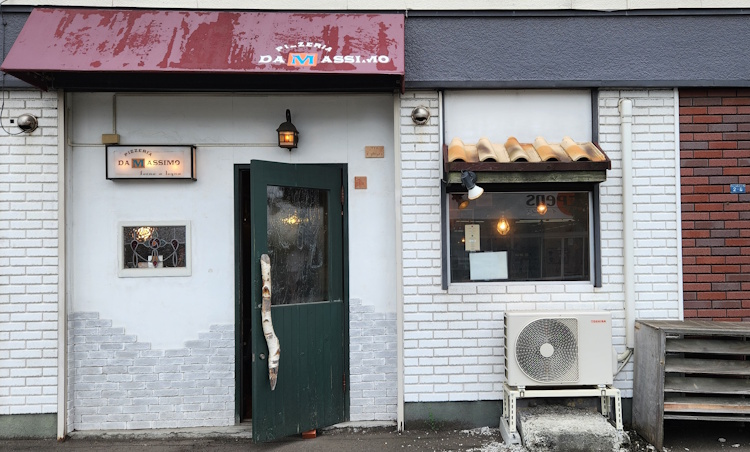
My first visit to Sapporo’s Da Massimo Pizza was last Fall. I had tried to come by for a pizza at least two other times, but you should note:
This shop has very limited hours. They are open for lunch from 11:30 to 2 PM (probably have “last order” closer to 1:30, don’t push your luck). And for dinner, they are open for one and half hours only, from 5:30 to 7 PM. (That is shocking to me, but it’s true.) On the first night I came by, the kitchen was clean by 6:30, and we were on the street by 7 PM. Get the hours right, or you’re not going get a pizza.
With that said, the pizza is so good, it is worth the effort to get the timing right.

As I walked in to Da Massimo in Sapporo a little after 11:30 (just after they open) on a Thursday in July, there was a nearly a full house. The two tables had a couple of people each. And the 6-person counter had four people already, and they stuffed me in as the fifth. A minute or so after me, two people showed up and that had to wait 15 minutes for a spot. Maybe not always, but it can be crowded at lunch.
It is a simple shop. A few seats, and from nearly all of them you can look right into the kitchen.
Even the menu is simple: exactly two kinds of pizza and few things to drink. That’s it.
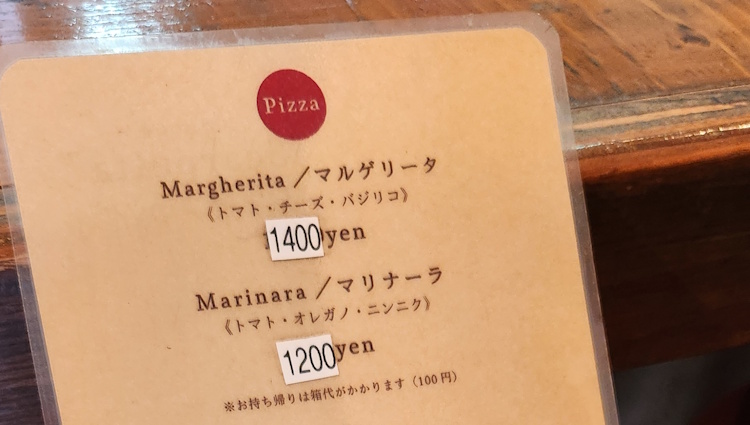
The main attraction at Da Massimo is Naples-style pizza. On a decidedly simple menu, the two choices are; the Margherita (1400 JPY), which comes with cheese and some basil; and then there is the Marinara (1200 JPY), which is garlic, oregano, no cheese. That’s it. That is the menu.
So as one of just a few times in my life, I ordered what is in essence, a tomato sauce pizza (the only other times I have ordered a marinara pizza was here on my previous visit, and again at Seirinkan Pizza in Tokyo).
The smells in the air at Da Massimo alternate between the scent of burning dough and then sweet tomato-garlic-oregano aroma. Depending on which pizza he’s making, there can be also occasional bright bursts of basil as well.
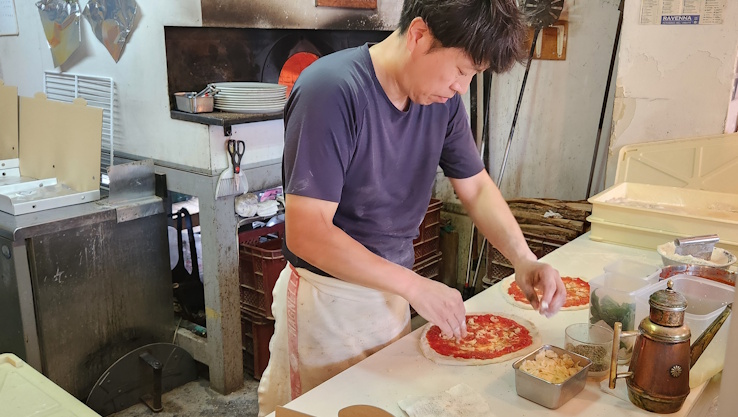
I watched him assemble my Da Massimo marinara pizza: First the dough, shaped, corners cut off. Then the sauce, applied with a spoon from a metal bowl. Then a liberal sprinkling of oregano. Then ample shaved garlic. Then, oil from the brass pitcher, and – no cheese.
As you’ll read in this review, I was paying a lot of attention to the pizza chef, and he was very friendly. I took an obscene amount of pictures, and my host was accommodating, even welcoming. It does seem to be part of the tradition that the making of the pizzas is intended to be seen… and perhaps photographed. And I played my role as the attentive observer.
It was after I’d ordered, that I began to settle down, and study the place.
From my spot at the counter, I could watch the production: The shallow yellow box, with two rows of rounded-square portions of dough. The shiny bowl with sweet-tomato sauce. A small rectangular metal tin, full with shaved garlic. A low, round, glass cup filled with dry oregano.
I also heard the rapid, repetitive noise of the pizza sensei – pressed against a stack of dinner plates next to the oven, leaning over his most freshly baked pie – he makes the sound; scart, scrat, scrat, scart, scart… after the pizzas are cooked, scrapping the burnt edges off of the burnt dough.
It hadn’t been on my mind, but as I heard the sounds I could remember it from the previous visit. That scart, scrat, scrat – is not how they do it everywhere, but it’s how he does it at Da Massimo.
Here is note I took on my first visit:
“Our pizza caught fire, and I was curious if he’d give it to us anyway. He did, but only after scrapping off the burnt part.”
It may be wise for me to correct the record: I cannot be sure that our pizza caught fire on my first visit. However, I have come to learn that part of the art of the Da Massimo pizza is getting a very delicious dough, very close to the fire; creating those “black spots” is certainly intentional (that process is sometimes called “leoparding” in the pizza business).
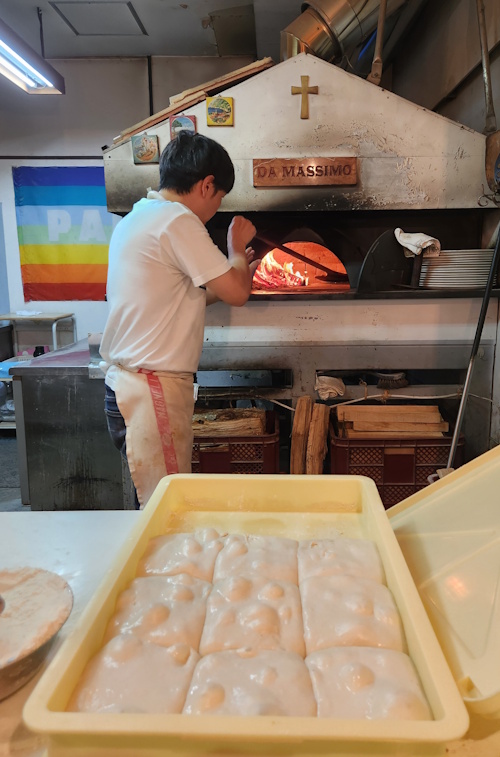
After the raw ingredients are assembled, the process of baking a Da Massimo Neapolitan pizza continues as the pizza master uses a long, well-worn wooden peel to introduce the pizza to the brick oven. Then, he changes to a metal peel to turn, and shift the pizza’s position and proximity to the fire.
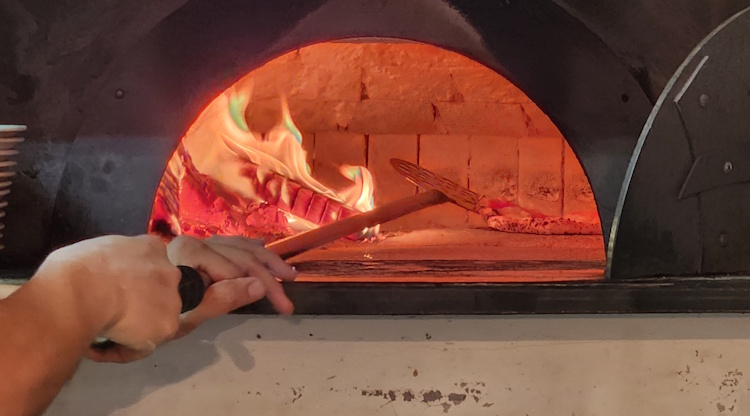
From the counter you can watch him intentionally lift the pizza up, towards the flames that spread across the roof of the oven.
Just look at that pizza. Dead simple, but beautiful.
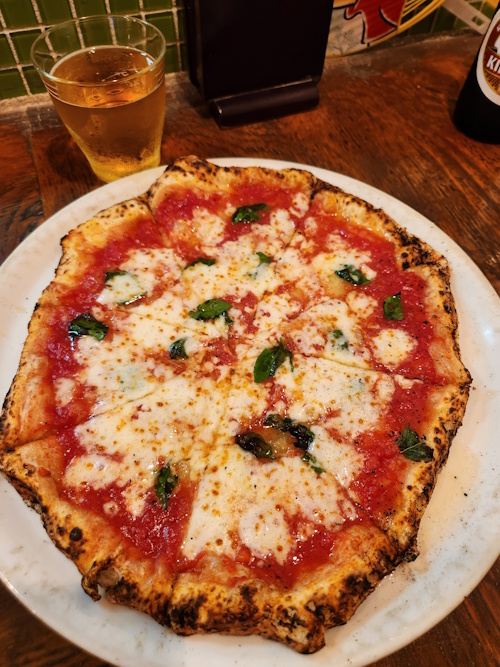
The marinara pizza at Da Massimo – a garlic powerhouse – is exquisite. An absolutely stripped down, minimalist pizza, the remaining ingredients come through – each with a clear, independent voice. Napoletana is not at all my favorite kind of pizza, but Da Massimo is painfully good, I am am almost forced into rare and reverent appreciation.
Even unladen with toppings as it is, the pizza is so thin-crusted, and well-oiled, it cannot support it’s own weight. It “fails” the pizza test; it cannot easily be eaten by hand, except by arranging your face under each slice and lowering the pizza in for a garlic-y bite.
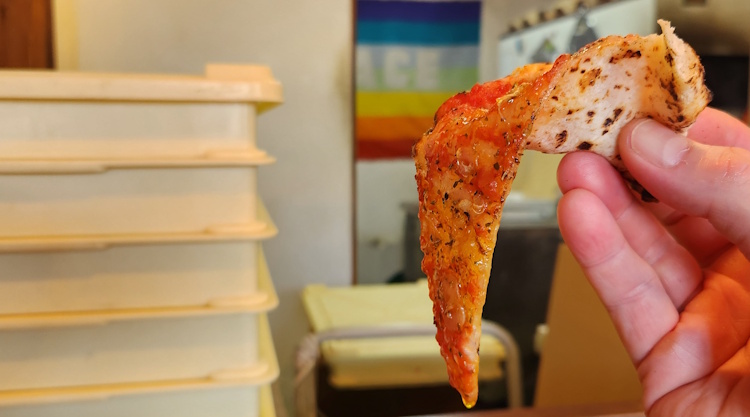
One patron – down-counter from me – used his fork to fold the point of the slice back toward the crust, two times, and then, in it’s rolled-up form, dared to pick it up.
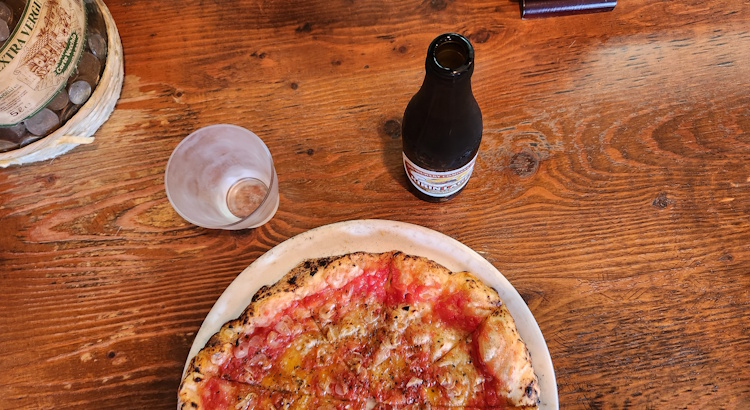
Let’s talk about the olive oil (or as the Japanese would pronounce it, “o-rib-oi-e-ru”).
Part of the reason why the intentionally-authentic Napoletana pizzas are hard to pick up, is because of that pour of oil onto the pizza just before it goes into the oven. High-quality olive oil likely adds to the taste and richness, but does weighs it down, making each pizza more soft and “liquidy” – that kind of crust is not as easy to eat by hand as most American-style pizzas.
As we mentioned earlier in this post: At Da Massimo, he lifts the pizzas up to the flames, tilting them to get sections of that crust into just-perfect position to create the dark-spot flavor he wants in every bite. As he does this, some of the excess oil spills off of the pizza, and on to the hot surface of the oven. And – catches fire.
From my notes:
“Little piles of fire where the oil spills off of the pizza and into the hot stone and begins to burn off.”
From my position during my lunch visit, I could not see the wood-part of the fire (only the flames flicking along the ceiling of the oven), but I could see those little “piles of fire” burning. After each batch of pizzas (he usually cooks two at a time), he would then use a pole with a brush to reach into the oven and scrub the surface of the stone, removing the burning oil and it’s burned remnants.
The story of the oil continues on the back of the pizza menu at Da Massimo Sapporo, with a description of “scarpetta.” Scarpetta is an Italian word that describes a culinary custom related to cleaning up all that extra oil that ends up on the plate:
“Fare la scarpetta properly means leaving an almost-spotless dish.
Fare la scarpetta is the act of tearing a chunk of bread off of a loaf, pinching it between your right thumb and index finger, and dragging it around an almost-empty plate – often of pasta – which still has dollops of sauce. Once the piece of bread is sufficiently coated with sauce, it is lifted and gobbled up in order to savor every last bit.”
— Carlotta Panza, Italysegreta.com
Da Massimo teaches you a bit about scarpetta on the back of the menu, about how the oil relates to the charred crust, and encourages you to use the remaining pizza crust to mop up that oil.
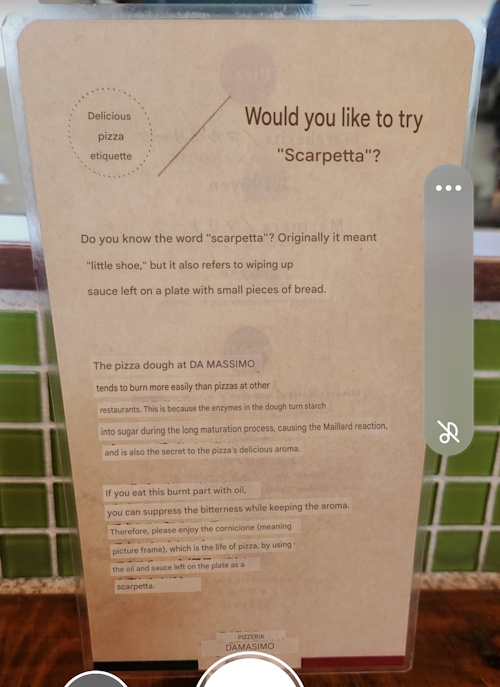
Mixed with the love and appreciation for the taste of Da Massimo pizza, this has been a somewhat technical report on the pizza making process. If you’re still with me, we can add a little more of that kind of detail to this review:
Q: How long does it take to cook a pizza?
The time it takes to cook a pizza depends entirely on the style of pizza and the type of oven. As for Neapolitan pizza, the ovens are very, very hot. And many people will say it takes “90 seconds” to cook a Napoletana pizza, but in my experience that is not correct.
Neapolitan pizzas are actually in the oven for only 45 – 50 seconds. That is a fast pizza, indeed.
As Pizza Czar of Japan, I travel around the country eating pizza. On a recent trip to Tokyo, I sampled some pizza at Savoy Asabujuban, in Minato City, Tokyo. As we sat at the counter watching them make pizza, we counted the time in the oven. About 50 seconds. We were just counting in our heads. This time, I actually used a stop-watch function on my phone.
I recorded the baking time for a Neapolitan pizza at Da Massimo. The first example was 45 seconds. The second time I used my stopwatch to record the cooking time, it was 46 seconds. The pizza cook is not using a timer; he is looking at the condition of the pizza crust, controlling that condition with his skill and experitise, and pulling the pizza out of the oven when he deems it ready. In the end… 45 seconds is about the right amount of time.
Just in case you are lost in the details of this review of Da Massimo Pizza in Sapporo, I’ll make it explicit: I am a big fan. I love this shop and am looking forward to going back.
The (marinara) pizza is very garlic-y, which is a feature that sticks with you for a few hours after the pizza. After my recent lunch, I wanted some sweet chocolate to clear the savory taste out of my mouth after the meal (as is my personal custom); I took the bus, and then the train, back to Odori station, and bought a chocolate scone at Johan Bakery in Mitsukoshi. It was a really nice afternoon.
Despite that thin crust, a Massimo pizza is a clear winner. We rate Sapporo’s Da Massimo as a “9” (which may be a little too generous, only because the shop is a little hard to get to via public transportation, and because his hours are so limited, but…), the pizza itself, is remarkably good.
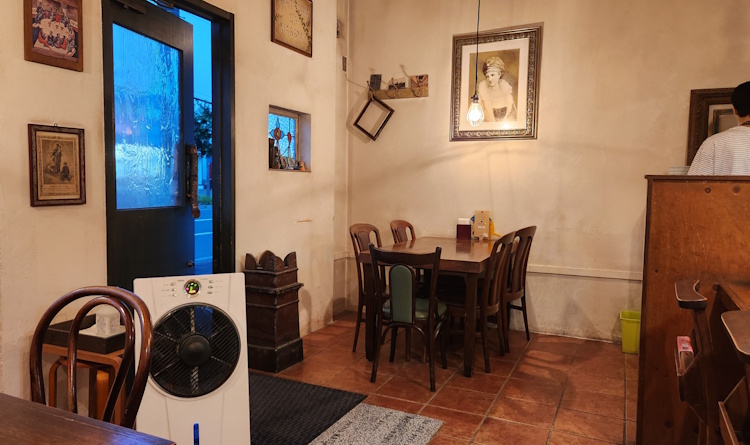
The shop is small. The exterior is a little run-down, which is very “Sapporo” (as of 2025, we are not a particularly modern city). The signs are a little rusted. The interior, with mismatched wooden chairs, is simple, but comfortable. And with all that, it is an excellent experience, modeled after Naples, but very much with it’s own distinction.
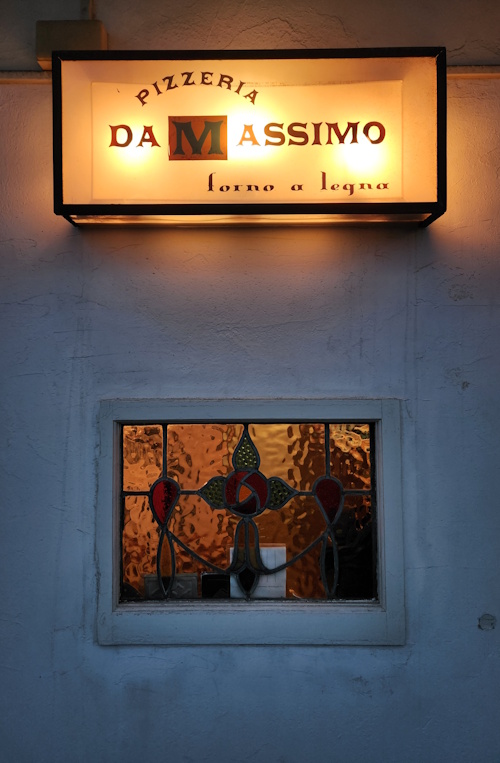
Once again, be sure to check the hours: His business card says he’s open until 8 PM for dinner, but that is not true. Each time I’m there, he offers to scratch that part out, and write in the correct hours – he is open until 7 PM for dinner (and last order is probably 6:30 or earlier).
Because the lunch hours are a little longer, it might be safe to say Da Massimo is more of a lunch spot.
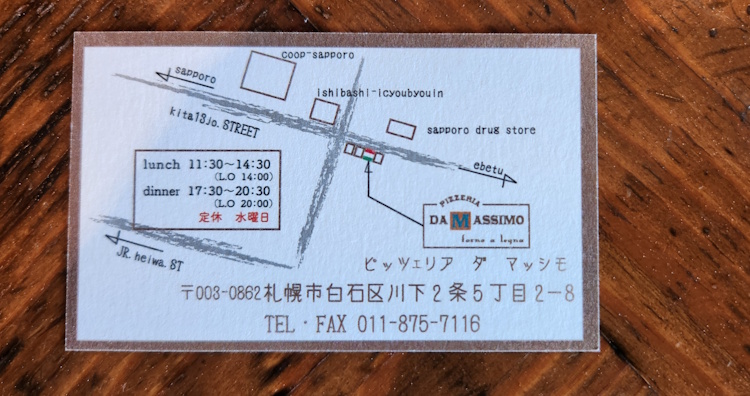
With all that said, there is “to go” pizza at Da Massimo, Sapporo. He took several orders over the phone, and one guy waited in person, and then took the pizza away in boxes. If you’re driving, “take away” pizza at Da Massimo is another way to enjoy the flavor.
Highly recommended.
